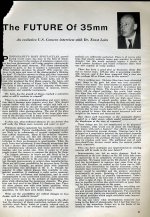You are using an out of date browser. It may not display this or other websites correctly.
You should upgrade or use an alternative browser.
You should upgrade or use an alternative browser.
What Ernst Leitz had to say in 1957
- Thread starter Lazlo Toth
- Start date
- Latest activity Latest activity:
- Replies 12
- Views 1K
FrankS
Registered User
"Why should anyone bother with the additional bulk and weight of a larger camera when he can get the same quality negative from a 35mm..."
Hmmm, haven't we gone over this before?
Hmmm, haven't we gone over this before?
Solinar
Analog Preferred
The interview reveals much about the mind set of the interviewer as well.
It doesn't appear that either gentlemen foresaw the rise of SLR cameras.
It doesn't appear that either gentlemen foresaw the rise of SLR cameras.
Solinar
Analog Preferred
Frank, I thought the same thing.
FrankS
Registered User
Technically, the 35mm does have the same (or better quality) than a MF negative, but in order to make prints, the 35 will have to be enlarged to a greater degree (to make the same sized print) and this creates a deterioration of the final print image compared to a MF final print image. No one contact prints 35mm negs as the final print, it is meant to be enlarged, hence the difference in the degree of enlargement has to be considered in this argument. Just like with horsepower, you can't beat greater square/cubic inches in a motor. That's the last I'll say on this topic. 🙂
Last edited:
maddoc
... likes film again.
I completely agree. However, what Leica started was creating a 35mm film camera system, which can keep up to a certain print size (the size an amateur would print maximal) with the 6x6 film but better portability. On the other hand, a Leica MP with silver 50mm Summilux pre-ASPH is of the same weight as a Rolleiflex 3.5E ... 😕FrankS said:Technically, the 35mm does have the same (or better quality) than a MF negative, but in order to make prints, the 35 will have to be enlarged to a greater degree (to make the same sized print) and this creates a deterioration of the final print image compared to a MF final print image. No one contact prints 35mm negs as the final print, it is meant to be enlarged, hence the difference in the degree of enlargement has to be considered in this argument. Just like with horsepower, you can't beat greater square/cubic inches in a motor. That's the last I'll say on this topic. 🙂
erikhaugsby
killer of threads
Same mass, very different form factor, size, and useage characteristics. And the Rollei lens is a f/3.5, not an f/1.4.maddoc said:On the other hand, a Leica MP with silver 50mm Summilux pre-ASPH is of the same weight as a Rolleiflex 3.5E ... 😕
maddoc
... likes film again.
erikhaugsby said:Same mass, very different form factor, size, and useage characteristics. And the Rollei lens is a f/3.5, not an f/1.4.
I know ... 🙂
laptoprob
back to basics
What strikes me is the full stress on existing possibilities and techniques. No hint of thought towards automatic exposure, as if being too difficult and expensive.
But maybe being on the top back then, together with the competition aiming for faster and better lenses, AE simply was a bridge too far. Leica didn't do AE until the M7, right? Following the competition...
But maybe being on the top back then, together with the competition aiming for faster and better lenses, AE simply was a bridge too far. Leica didn't do AE until the M7, right? Following the competition...
M. Valdemar
Well-known
He also settles the question of whether there was "radioactive glass" in the early collapsible Summicron. It's true.
Roger Hicks
Veteran
Well, no, it wasn't doable for the Japanese either, for exactly the reasons he gave. No-one has yet made an interchangeable-lens RF camera with shutter priority, and until the advent of electronically governed FP shutters (still well in the future at that point) the aperture-priority interchangeable-lens RF was all but impossible too. In fact I don't think anyone made one until the interchangeable-lens Hexar, though I could be wrong. Fixed-lens automation on 35mm was another matter and appeared 2-3 after the interview: Ricoh, Durst, Canonet.
It's easy to look back from 2007 and think that he was short-sighted, but put yourself in 1957 and things look a bit different.
Cheers,
Roger
It's easy to look back from 2007 and think that he was short-sighted, but put yourself in 1957 and things look a bit different.
Cheers,
Roger
Chriscrawfordphoto
Real Men Shoot Film.
M. Valdemar said:He also settles the question of whether there was "radioactive glass" in the early collapsible Summicron. It's true.
I thought he was denying that they used radioctive glass....that stuff about finding a different glass withou the dangerous stuff to protect his workers and keep his plant from being contaminated.
Spider67
Well-known
Thanks that was quite an intersting read!
On the one hand a pity that they did not work in the direction of the "electronic camera" on the other hand it would have jsut been like before: A revolutionary product whcih fisrt is copied by other manufacturers and then further developed until it's cheaper produce....
On the one hand a pity that they did not work in the direction of the "electronic camera" on the other hand it would have jsut been like before: A revolutionary product whcih fisrt is copied by other manufacturers and then further developed until it's cheaper produce....
Similar threads
- Replies
- 3
- Views
- 214
- Replies
- 3
- Views
- 356
- Replies
- 53
- Views
- 3K
- Replies
- 34
- Views
- 600




